| It was not
until 1953 that my
relationship with the
Essoldo Bethnal Green truly
began. It was then that
my opinion of the cinema changed
or rather was viewed in a
different light. It was
on a wet Monday afternoon
that the old and slightly
dilapidated cinema was
seen through refreshed
eyes. Up until that
Monday afternoon, if I
had thought about that
cinema, I would have
quickly dismissed it as a
dump, a fleapit, a
third-rate establishment
of little interest and
importance. Brutal
comments from one so
young! However, on that
faithful day, and quite
suddenly, the cinema
became elevated to
rarefied heights and
became a favourite for
all time. My change
of heart came about as a
result of two events,
both involving Mr.
Solomon Sheckman: the
first brought the cinema
into his Essoldo
circuit in 1949 and
the second came about as
a result of the his savvy
business sense in
1953. Obviously a
good businessman and a
person with foresight,
once Mr. Sheckman saw an
opportunity, he seized
upon it with both hands.
His know how brought
his cinema circuit to
national prominence and
allowed it the good
fortune to show the films
produced by 20th
Century Fox now
produced in CinemaScope
– the Essoldo
chain’s gain was
the Rank
Organization’s loss. 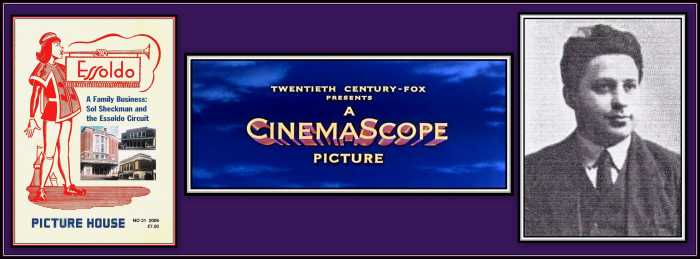
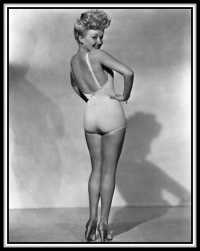 20th
Century Fox originally
insisted that their CinemaScope
films not only be
seen on a huge wide
screen but also heard in glorious
stereophonic sound.
Up until then, the Rank
Organization was
distributing Fox films
and I had enjoyed many
Betty Grable films
at the Foresters
cinema by then (link to Going
to the Pictures –
Foresters, a Gaumont
cinema). Apparently
the Rank Organization was
unwilling to upgrade the
sound system in all of
their managed cinemas. 20th
Century Fox was
initially adamant in this
demand and negotiations
between the two companies
broke down causing Fox
to look for another
outlet for their films.
Obviously sensing that CinemaScope
was just what was
needed to lure the public
back to his cinemas and
allow his circuit to
challenge the major
distributors in Britain,
Solomon Sheckman and the Essoldo
chain stepped in and
offered their
establishments to Fox.
The management of the
Essoldo chain
was happy to agree to all
demands made by Fox
and so became a force in
the business. For several
years, the Essoldo
chain enjoyed good
business by showing many first
run films that
patrons wanted to see.
However, Fox and Rank
eventually overcame their
differences and the Essoldo
circuit returned to its
previous screening policy
of showing films of less
than sterling quality.
But by then, I had moved
from Bethnal Green, much
to my chagrin, and
was viewing CinemaScope
in the grander
setting of a Granada cinema. 20th
Century Fox originally
insisted that their CinemaScope
films not only be
seen on a huge wide
screen but also heard in glorious
stereophonic sound.
Up until then, the Rank
Organization was
distributing Fox films
and I had enjoyed many
Betty Grable films
at the Foresters
cinema by then (link to Going
to the Pictures –
Foresters, a Gaumont
cinema). Apparently
the Rank Organization was
unwilling to upgrade the
sound system in all of
their managed cinemas. 20th
Century Fox was
initially adamant in this
demand and negotiations
between the two companies
broke down causing Fox
to look for another
outlet for their films.
Obviously sensing that CinemaScope
was just what was
needed to lure the public
back to his cinemas and
allow his circuit to
challenge the major
distributors in Britain,
Solomon Sheckman and the Essoldo
chain stepped in and
offered their
establishments to Fox.
The management of the
Essoldo chain
was happy to agree to all
demands made by Fox
and so became a force in
the business. For several
years, the Essoldo
chain enjoyed good
business by showing many first
run films that
patrons wanted to see.
However, Fox and Rank
eventually overcame their
differences and the Essoldo
circuit returned to its
previous screening policy
of showing films of less
than sterling quality.
But by then, I had moved
from Bethnal Green, much
to my chagrin, and
was viewing CinemaScope
in the grander
setting of a Granada cinema.
I cannot
impress upon the reader
the sheer magnificence of
CinemaScope. The
screen seemed huge to me,
very wide, yet seemingly
narrow in height thanks
to the projected
aspect ratio of
supposedly 2.66:1.
I had never experienced stereophonic
sound before and was
amazed at the effects
achieved. Horses and
chariots were heard
clattering along cobbled
streets while off-screen,
thereby making their
entrance on-screen, greatly
anticipated and all the
more exciting. Without
doubt, I felt myself part
of the film and was
willing to swallow the
occasional weak storyline
and kissing that
interrupted the action!
What made
the new screen and new
sound system even more
spectacular were my
memories of the pre-CinemaScope
screen of the Essoldo along
with the quality of the
old sound system. I
remember that the old
screen was set back quite
deeply allowing a large stage
area before the proscenium.
I also recall that the
old screen was taller
than it was wide and had
some curvature at the
corners. If this were
true, the screen
obviously would have
failed to conform to Academy
Format where a projected
aspect ratio of 1.37:1
was required.
I had never seen a screen
like the pre-CinemaScope
screen before and, of
course, it is possible
that I should not trust
my memory in this matter.
Real or imagined, I found
the old screen odd.
The CinemaScope
screen was not only
very wide, but it
demonstrated a slight
curvature. 20th
Century Fox unashamedly
advertised the new screen
with an exaggerated
curvature, as one of
their original
advertisements for The
Robe clearly
demonstrates and as did
their logo for the
cinematic process.
Regardless of this, what
was amazing about CinemaScope,
and here I can
personally attest to the
validity of this effect,
was that if you sat in
the centre of the fifth
or sixth row from the
front stalls, seats most
patrons would normally
avoid, then you found
that activities taking
place on the whole
screen filled the
viewer’s visual
field. This is to
say, what was shown on
the whole screen filled
your viewing area
and, as a result, you
were not aware of
anything else. This gave
you the impression of
actually being in the
film! Naturally, this
effect was helped
if there weren’t
other customers in the
rows in front of you. In
order to experience the full
majestic effect of
CinemaScope on a
regular basis, I
found it absolutely
necessary to skip
school and see these
films during the early
afternoon so as to be
sure to have the cinema
mostly to myself. As you
can tell, I was very,
very impressed by CinemaScope.
It allowed me to marvel
at the productions.
One afternoon, I might be
in ancient Rome (The
Robe), another time,
I might be sailing the
China Seas (Soldier
of Fortune) and on
another occasion, I could
be galloping across
the central plains with
the Cheyenne (White
Feather). In those
days, CinemaScope opened
up the world to me and
helped enrich my vista
and fuelled my
imagination. It also
caused me to want to
travel to those places
seen on the screen once I
got older. Finally, and
on a more negative, and
somewhat irritating note,
CinemaScope caused
me much trouble with
school authorities since
I never could offer them
suitable and acceptable
excuses as to why I was
absent from school on so
many Monday afternoons!
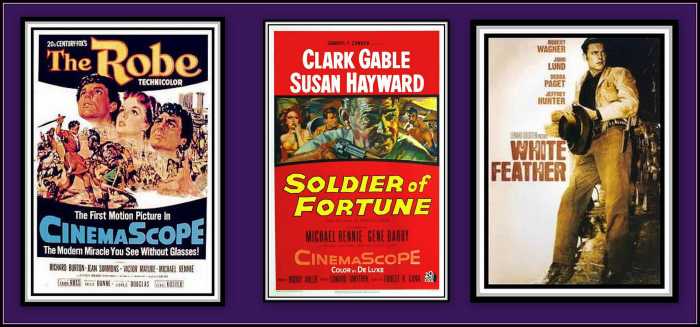
CinemaScope
was said to allow the
viewer to experience a
sense of depth without
the aid of special
glasses. I never
truly experienced this
and it wasn’t until
I first saw Cinerama that
I experienced this
concept. I remember
Richard Widmark standing
on the front of a moving
locomotive in How
the West Was Won
and gasping at
the sense of depth now
noticeable as the train
moved towards the
audience.
In order
to accommodate the
wide screen required
to allow projection of CinemaScope,
changes had to be
made to the cinema. As a
result of the new and
necessary projected
aspect ratio, a new
screen had to be
installed and it had to
be placed in front of the
proscenium at the Essoldo,
Bethnal Green. As a
result, there were no
longer any curtains or proscenium
with decorative
motifs separating the
screen from the
auditorium. Judging from
old photographs, this was
indeed a loss to its
charm. Even as a child, I
remember being amused by
the dark material chosen
to shape the
screen. It did not seem
to be of the normal black
canvas used in other
cinemas, but appeared to
be akin to old
blankets!
 The
first film in CinemaScope
that I saw at the Essoldo
was The Robe. I
had had the opportunity
to see Flight of the
White Heron, which
had played there for a
week about a month
earlier, but since I was
not especially interested
in the voyages of the
Queen following her
coronation, I did not go.
I deeply regret this poor
choice now since I have
never again had the
opportunity to see this
film. I fear that it is
amongst the lost. The
first film in CinemaScope
that I saw at the Essoldo
was The Robe. I
had had the opportunity
to see Flight of the
White Heron, which
had played there for a
week about a month
earlier, but since I was
not especially interested
in the voyages of the
Queen following her
coronation, I did not go.
I deeply regret this poor
choice now since I have
never again had the
opportunity to see this
film. I fear that it is
amongst the lost.
In those
days, one did not pay
attention to when films
began and ended. When one
wanted to go to the
cinema, one went in
regardless of what point
the screening had reached
and then one stayed until
one saw the whole film
through regardless of
having seen the ending
already. I remember
having my ticket torn by
the usherette and then
being allowed to go
through the doors to the
auditorium. The place was
almost pitch black. I
looked ahead and was
surprised by the enormous
screen stretching across
what seemed to be the
whole width of the
building at the far end
of the auditorium. I was
stunned and froze in
place. The scene was dim
and slowly I began to
make out that it was of a
cabin on an old ship. I
remember that the cabin
moved gently back and
forth as the ship glided
through the waters. I
could hear the sound of
someone obviously beating
time for the oarsmen to
pull to. Richard Burton
was having a
nightmare and reliving
his part in the Crucifixion.
He was tossing in his
bunk and murmuring
inaudible dialogue. It
was quite a creepy scene.
Periodically, he would
yell out some
chilling dialogue thereby
terrifying the
ship’s crew and me
and caused some
disruption to their
rowing. Meanwhile, my
ears were ringing with
that constant hammering
sound that filled the
auditorium and added to
the eeriness of the mood.
Even though I had no idea
what was going on in the
scene, I still found it
to be quite disturbing.
Fortunately, as the film
progressed, I got the gist
of the story and was
able to follow and
eventually enjoy it.
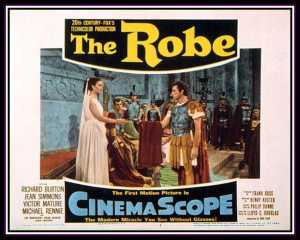 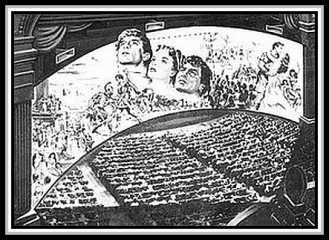 The
Robe had been chosen
by 20th Century Fox to
be the first film
released that was made in
CinemaScope. The Fox
executives were
determined to make the
maximum of their new
process and decided that
their first film should
be one where they could pull
out all the stops
and produce a spectacle.
They certainly
achieved their aim. It
not only made money, it
also spawned a sequel,
which went into
production immediately
after completion of The
Robe so as to
maximize returns on their
initial outlay on the
cost of the sets. The
film set the scene for
further epics that were
to follow throughout the
1950s. The
Robe had been chosen
by 20th Century Fox to
be the first film
released that was made in
CinemaScope. The Fox
executives were
determined to make the
maximum of their new
process and decided that
their first film should
be one where they could pull
out all the stops
and produce a spectacle.
They certainly
achieved their aim. It
not only made money, it
also spawned a sequel,
which went into
production immediately
after completion of The
Robe so as to
maximize returns on their
initial outlay on the
cost of the sets. The
film set the scene for
further epics that were
to follow throughout the
1950s.
What I
liked best about The
Robe, besides the
magnificent arena and
court scenes, was the Emperor.
The film is set
during the time of the Emperor
Tiberius, who we
meet living out his old
age on the Isle of
Capri and centres
around the centurion
Marcellus who
commanded the Crucifixion
of Jesus. Marcellus wins
Jesus’ garment when
soldiers cast lots for
it. His servant, Demetrius,
played by Victor
Mature, takes The
Robe when he leaves Marcellus’
service. Marcellus,
for his part loses
his reason and is
sent back to Rome.
Eventually, he is given
an audience with Tiberius
who after discussion
sends Marcellus off
on a quest to find The
Robe since Tiberius
believed that it has powers!
It is
evident that the Fox
moguls were not
going to waste time on
historical accuracy
regarding the order and
life spans of Roman
Emperors in their film
and since they dispensed
with any reference to the
Emperor Augustus and
swiftly move to the
obviously more marketable
Caligula. By
focusing on his manner,
tastes and cruelty, the
moguls were able to tease
and titillate the public
and indulge the macabre
side of their taste.
After all, this is what
sold and still sells
tickets! It must be
remembered that the
moguls were primarily
businessmen and were much
more interested in their
bottom line than in
producing historically
accurate films.
Up until
then, the great Peter
Ustinov had set the
standard for madness and
over indulgence of a
Roman Emperor with his
portrayal of the Emperor
Nero in Quo Vadis in
the early 1950s. I
saw this film at the ABC
Mile End Road one
Thursday night when it
first went on general
release. I remember that
the advertisement
screamed that the film
contained a cast of
thousands, which it
seemed to. It also
promised the throwing
of Christians to the
lions! Being a child,
I took this assertion in
a literal manner and
believed that these poor
people were to be hurled
into the arena. Actually,
they all walked into the
place and some even sang
as they did! We had gone
to see this film at the
insistence of my father,
an obvious devotee of
spectacle and over
the top Roman
Emperors. I have been
lucky enough to see this
film on giant screens a
number of times and it is
without doubt one of the
better and more
spectacular epics.
However, what makes the
film memorable is the
acting of Peter Ustinov.
I am still able to laugh
out loud, as I did at
that first viewing, when
the Emperor Nero,
played by a young Peter
Ustinov, while in
a supposedly sad mood,
calls for his tear
glass! For some
reason, the calling for
such an object is still
amusing to me!
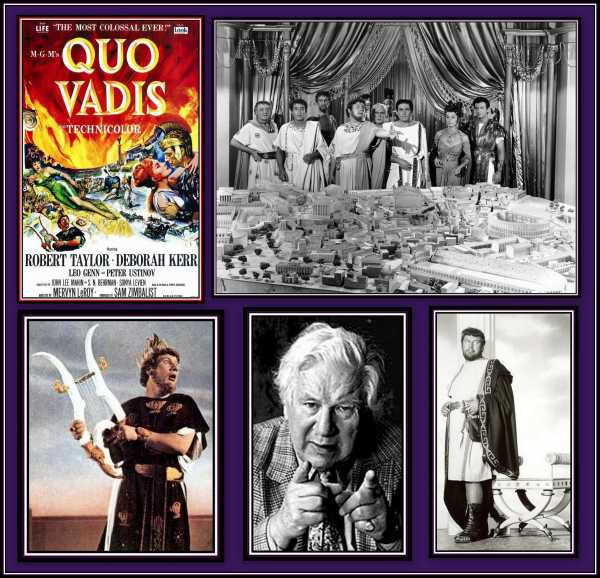
In my
opinion, in 1953, with
the release of The
Robe, Jay Robinson
rivalled Peter
Ustinov for
entertainment and camp
with his portrayal of Caligula.
What set his
interpretation apart was
that he introduced a
sense of true evil
into his role and,
despite finding his
portrayal amusing, I also
found it quite
frightening. I could see
that the character was
quite capable of doing
the most heinous of acts.
As great as Peter Ustinov
was as Nero, even
at my young age, I found
him more amusing than
frightening. Jay
Robinson, although
playing Caligula to
the hilt of camp,
nonetheless infused a
creepy aspect to his
interpretation, which is
recognizable today in
this film and in its
sequel, Demetrius
and the Gladiators,
which was
incidentally an
entertaining film with a
great soundtrack and also
memorable for the
presence of Susan Hayward.
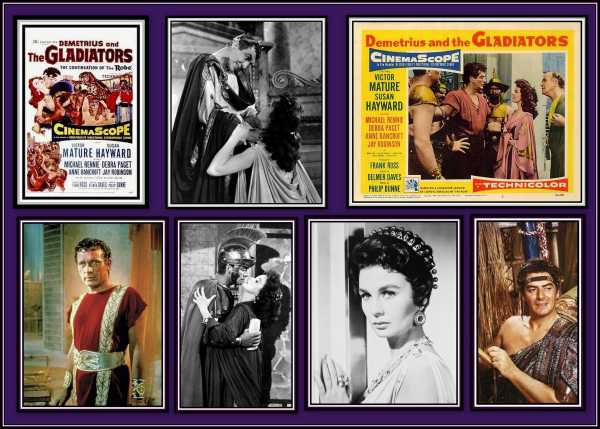
I sat
through a second showing
of The Robe and
marvelled on both
occasions at the finale
where Richard Burton and
Jean Simmons walked
out of Caligula’s
court and up into the
sky while this glorious
and triumphant music
played. This was great
stuff and easily lived up
to the promises made by
the advertisements of
this film. Unfortunately,
I was not able to sit
through another showing
since I was already late
in getting home.

My mother
was angry when I
eventually got home and
wanted to know why I was
so late in getting home
from school. Also, as it
was a Monday, I had to
take the week’s
laundry to the launderette.
At the best of times, I
did not look forward to
this chore and now I not
only had to go there and
watch as the washing went
‘round and
‘round in the
machine, but I would get
home even later than
usual and probably have
to go straight to bed. I
hated going to the launderette
although it did have
its compensations. One of
the women working there
would send me to buy her a
bag of chips from the
fish and chip shop further
along the Bethnal
Green Road. She was a
kindly and friendly woman
and always willingly
shared them with me. She
came from Yorkshire and
supported York City
Football Club, which
was having a good run in
the F.A. Cup that
year. That year the team
got to the semi-finals
and on their way had
defeated the mighty Tottenham
Hotspur, 3-1, in an
earlier round. I remember
that she bought me my own
bag of chips to celebrate
this event. Whenever I
check the football
results, I always
glance down to those of
the old Fourth
Division to see how York
City is doing. Sadly,
the team has seen better
days!
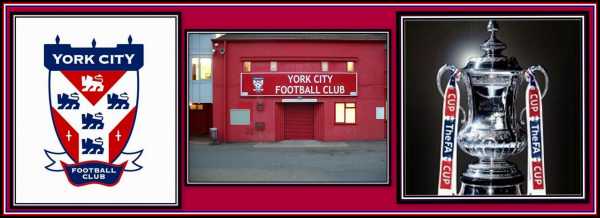
I saw many
20th
Century Fox CinemaScope
presentations
following The Robe until
being made to move out of
London in 1956. Although
I was able to see many of
the productions shown at
the Essoldo, unfortunately
I was not able to see
them all. And this
was of no fault of
my own! My inability to
see then all was due to
both the British Board
of Film Censors and
also to previous agreements
made by the cinema
with MGM and Warner
Brothers. This was,
and still is, a
great sense of annoyance
to me.
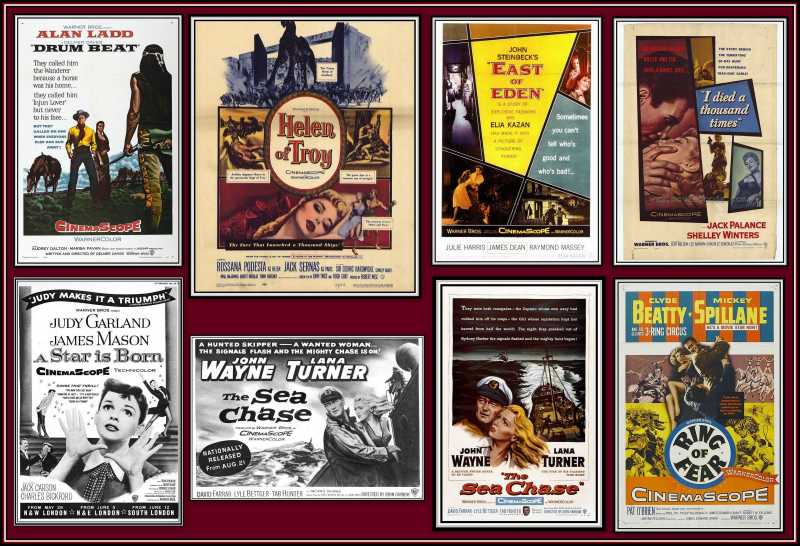
The British
Board of Film Censors was
responsible for viewing
all films to be released
in the British Isles and
awarding certificates
that stated who, and
under what conditions,
younger members of
society would be admitted
to viewing. Many films
received a U-certificate.
Such a status allowed
anyone and everyone into
the cinema to view the
film, assuming that they
were able to pay the
price of a ticket. This
was fine and allowed me
to see many Fox productions.
However, they also
awarded other certificates
detailing any restriction
to the admission of those
members of society under
the age of 16-years.
As I had mentioned
earlier, the Board awarded
X- and H-certificates,
which denied access
to anyone less than
16-years of age. Such
labelled films were not
generally a problem since
most major film studios
realized that these
certificates meant lower
revenues for their films.
As a result, they saw to
it that any possibly
offending scenes did not
find their way into the
final cut of their films.
Although there was
certainly a market for X-rated
films, they were
generally made by smaller
companies who produced
them on smaller budget so
as not to cut too deeply
into their profit
margin. I can only
remember 20th
Century Fox releasing
two films in Britain
produced in CinemaScope,
which were awarded an
X-certificate. These
films were Bigger Than
Life with James
Mason, which dealt
with steroid addiction
and The Fiend Who
Walked the West with Hugh
O’Brien, which
dealt with a fiend who
walked the West!
Years later, thanks to Cinemax
and the Fox Movie
Channel, I saw both
films and television and
yawned my way through
them both!

What did
cause me and my friends
problems at times was the
A-certificate awarded
by the Board. Such
a certificate limited
access to those under
16-years of age unless
accompanied by an adult.
This was not a problem
when I went to the cinema
with my parents, but
could become one during
those Monday afternoon
jaunts unless one
could persuade an adult
to take us in. This
meant asking complete
strangers, or
occasionally someone we
knew, to buy our tickets
for us. People today are
naturally very concerned
about contacts that their
children make. When I was
a child, a child also had
to be extremely vigilant.
There were bizarre people
out there contrary to
what many people will say
when recalling the past.
I had been brought up
never to do certain
things when I was out
with my parents. I had
been told to look for
certain responsible-type
people when I needed to
go to a public toilet or
when I got on a train
where there were
individual compartments.
I had been warned to keep
my wits about me and to
find a policeman if I was
concerned about anything.
Of course this was in the
days when the police walked
a beat.
I had also
been warned not to ask
strangers to take me
into a cinema no
matter how much I wanted
to see the film. And I
had promised faithfully
to never do so.
Naturally, children did
not always listen to
their parents and do not
always keep promises
especially when the drive
to see a certain film is
strong. With me and with
my friends, the wish to
see a film always won out
and strangers were
approached for help. I
was lucky with those that
I approached since I
chose carefully and I was
able to part company with
all strangers once the
tickets were torn. Still,
there were those times
when no stranger was
willing to take me in and
I was unable to see a
particular film. One film
that I missed and which
irked me very much at the
time was Garden of
Evil. This film
starred Gary Cooper,
Susan Hayward and Richard
Widmark, three
great favourites of mine
at the time. I had seen
Richard Widmark as a
child while he was
working on a film at Billingsgate
Fish Market and had
also seen him in 20th
Century Fox’s Hell
and High Water at the
Essoldo. Again,
years later thanks to Cinemax,
I saw the full-screen
version of this film.
Again, it was a
disappointment. The
storyline was somewhat
disjointed and moved at a
slow pace despite all the
fast and furious horse
riding that occurred in
the film. Unfortunately,
none of the actors were
at their best. What I
found most odd about this
film was that the actors,
at one point, were trying
to escape a group of
Indians. They were fired
upon and a number of them
were killed, yet the
audience never got to see
an Indian throughout
the film. This struck me
as both strange and
annoying, especially
since I have always
preferred Indians over
cowboys any day of the
week! I have to
confess that the real
star of this film was the
scenery. Some of the
scenes were set in a
Mexican village, which
had been destroyed either
by an earthquake or
volcano, I can’t
remember which. As a
result of this, some of
the scenes contained some
amazingly strange sites:
for example, one scene
included the steeple of a
church sticking up out of
the lava!
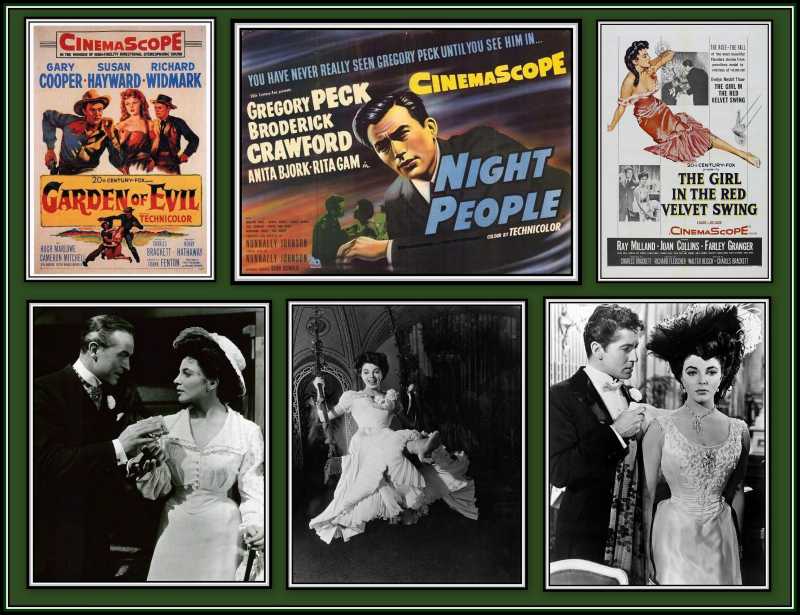
The second
reason for my not seeing
all of 20th
Century Fox’s
CinemaScope Productions was
due to their not being
shown at the cinema. Secondary
to some pre-existing
contract, the Essoldo
Bethnal Green was
required to continue to
show certain MGM and
Warner Brothers’ films,
which fortunately had
also been produced in CinemaScope.
I remember seeing a
number of good films
amongst these releases
such as Lucky Me,
A Star is Born, with
Judy Garland, Drumbeat
with Alan Ladd and
The Command, which
was the first western
made in the process and
was entertaining since it
contained lots of
Indians. I also saw The
Student Prince, which
is the film where Mario
Lanza had been
denied the right to play
the prince due to his
girth, but was allowed to
be the singing voice of
Edmund Purdom who
had replaced him thanks
to his slimmer frame. Seven
Brides for Seven Brothers
with Howard Keel and
Jane Powell was shown at
the cinema. 7B for 7B,
as this film was
advertised has become
famous for its dancing
sequences, which neither
of the mentioned stars
actually took part in.
The director Martin
Scorsese,
who is also a devotee
of CinemaScope, uses
the Raising of the
Barn scene from this
film to illustrate the
value and use of the
process to his classes of
film students at New
York University. As a
result of the need to
show these films, certain
20th
Century Fox’s
CinemaScope Productions were
bypassed for showing at
the cinema, but I will
return to this matter
later.
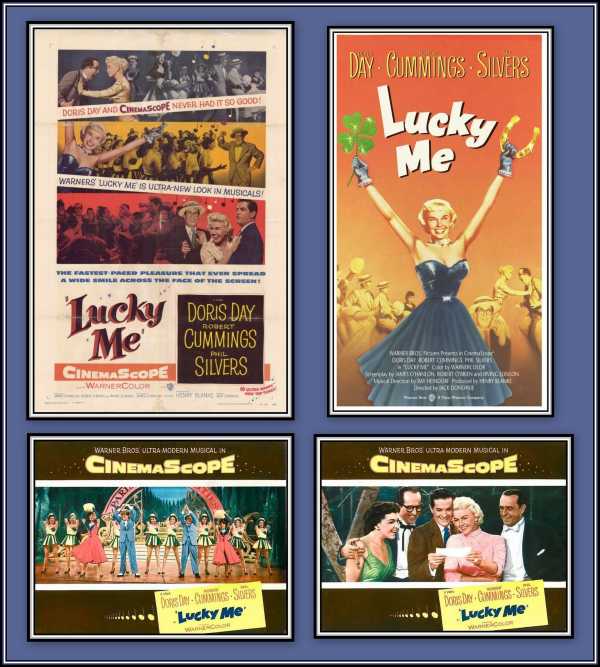
Lucky
Me was the first
musical made in CinemaScope
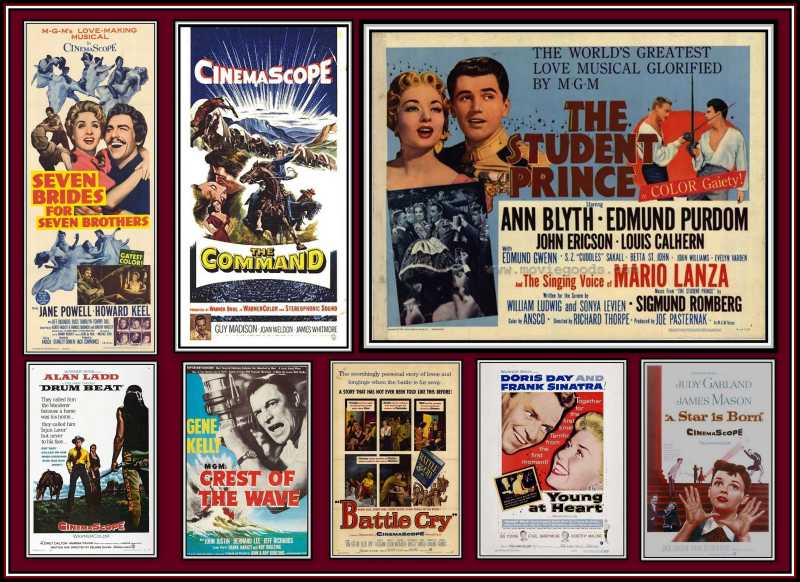
Seagulls Over
Sorrento was the
title of The Crest of
the Wave when the
film was released in
Britain
An MGM film
that was not shown at the
Essoldo Bethnal Green,
which I wish had
been, was Valley of
the Kings. This film
offered chases through
Egyptian tombs, down the
Nile and across the Sinai
Peninsula. Now who would
not want to such a film
when they were young? I
do recall that the Essoldo
forewent showing this
film in favour of
treating us to 20th
Century Fox’s King
of the Khyber Rifles,
with Tyrone Power. This
film contained chases
through the Khyber Pass
and skullduggery
in the British Army in
India. Despite my
regret at not seeing Valley
of the Kings, this
was more than compensated
by King. Later, as
a student, I spent a
summer in Egypt and was
able to travel through
the Valley of the
Kings astride a
donkey, float down the
Nile in a boat with a
large billowing white
sail and travel across
Sinai. Soon after the
film was shown in a small
local cinema close to
where I was living and
got to see many of the
sites that I had actually
seen shown in the film,
and yes, the chases were
still mildly exciting!
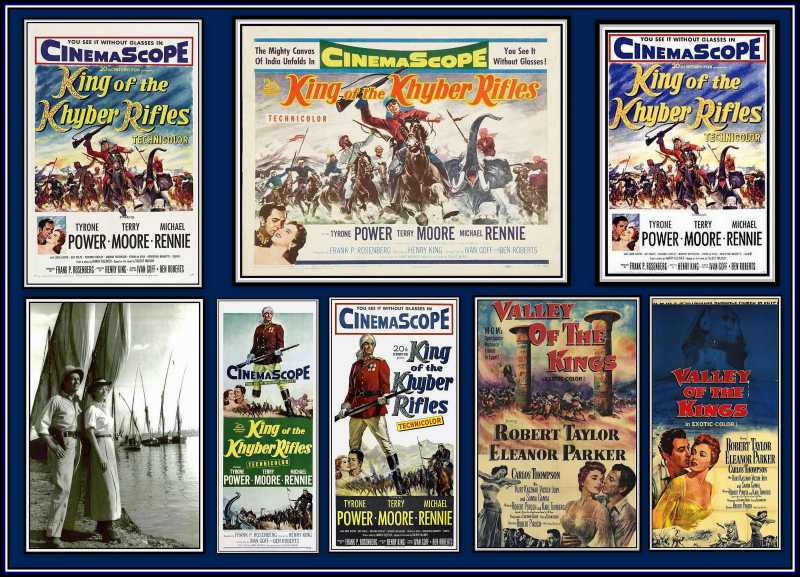
Although
the Essoldo Bethnal
Green did not show
all of the films released
by 20th
Century Fox in
Britain, they did show a
sufficient number, most
of which I got to see,
many with my pals on a
Monday afternoon and some
with my mother or with
both parents. My father
enjoyed musicals and one
that he insisted on
seeing was There’s
No Business Like Show
Business.
This was a film to
showcase the words and
music, as the
advertisement read, of Irving
Berlin. There were a
huge number of stars in
this film including
Marilyn Monroe. Despite
the stars and the music,
the film was somewhat
wooden, but was memorable
for Ms Monroe’s
interpretation of Heat
Wave,
which was both sultry
and seductive at times.
The other major stars
were Ethel
Merman
and Dan
Dailey,
who was a great favourite
of my mother. The film
also starred Johnnie
Ray,
who was extremely popular
at the time. I believe
that this was his one and
only appearance in film.
The other members of the
cast included the great Mitzi
Gaynor who was just about ready
to go into South
Pacific and the entertaining
and talented Donald
O’Connor.
My parents loved this
film and I liked Marilyn.
Mind you, I also like Mitzi
too and still do not
understand why she did
not make more films.
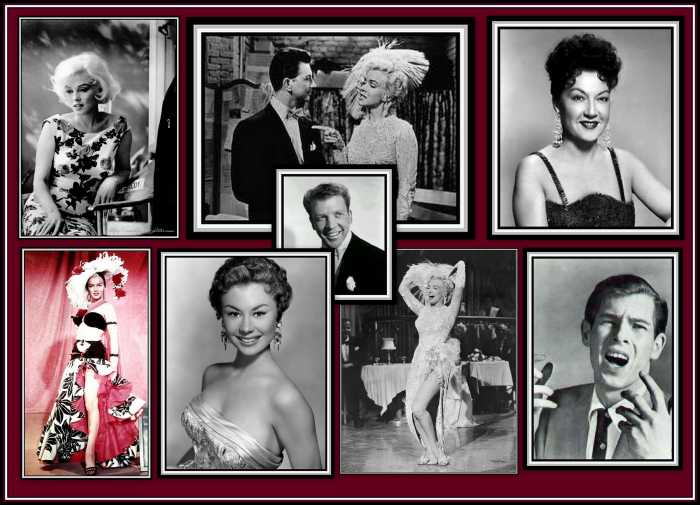
There's
No Business Like Show
Business
with Ethel Merman,
Dan Dailey, Donald
O'Connor, Marilyn Monroe,
Mitzi Gaynor &
Johnnie Ray
As I have
said, by this time, we
had left the pie
‘n’ mash shop
and my father was working
for British Railways
and doing shift work. When
he worked from 2 p.m. to
10 p.m., my mother and I
would often go to the
cinema on a Monday
evening. My mother always
wanted to go to the Excelsior,
which was her
favourite cinema. She
never seemed to mind
which film was being
shown, as she would be
sure to find it
enjoyable. My mother had a
history with the
cinema (link to come
– The Excelsior)
and found the Ex perfectly
suited to her tastes. She
always sat in the same
place: on the edge of
the row of the wide
central aisle. She
liked this seat since it
was close to the exit
– an absolute must
for my mother –
and also, she did not
have to stand up to allow
other patrons to pass.
Once my mother was comfortable,
she was loathed to
move. As the reader can
tell, it often proved
difficult to pry my
mother away from the Excelsior.
Although I
liked the Excelsior very
much and generally
enjoyed the films shown
there, once CinemaScope
became de rigueur,
the films of Universal,
Rank, Paramount and R.K.O,
which were shown
there, could not compare,
to my mind then, with
those of 20th
Century Fox. Although
many of the films shown
at the Excelsior were
advertised as being
produced in either CinemaScope
or VistaVision,
I fear that they were
not shown in these
formats. To my youthful
eye of the time, the post-CinemaScope
screen of the Ex
looked to be of the same
size as before. I have
since learned that many
films of that time were
in fact shown in what is
referred to as flat format.
At that time, films were
often filmed
simultaneously in widescreen
and regular (flat)
formats in order that
they could be shown in
all cinemas.
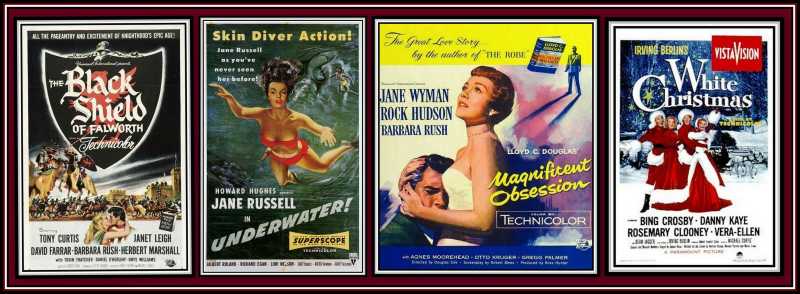
Regarding
many of the films seen at
the Excelsior, I
feel that it is only fair
to offer a confession.
Where once I
thought a particular film
as mediocre and
perhaps a trifle dull
when originally seen at
the Excelsior, I
have to admit that upon
re-seeing some, many have
proven it to be much
better and worthy of a
higher rating than
originally given. For
example, I once found Roman
Holiday to be of
little interest and
dismissed it with a yawn
– go figure!!! Similarly,
and often with great
reluctance, I have regretfully
found that many of
the spectacular 20th
Century Fox CinemaScope
Presentations to be less
than sterling upon
re-seeing. It disturbs me
to think that my taste
was not as good as I
thought when I was young!
Be that as
it may, whenever a new CinemaScope
film came to the Essoldo,
I had to see it.
Sadly, I often had to
resort to the telling
of a white lie to
convince my mother to go
there instead of the Excelsior.
However, whenever I
did convince her, it was
not always certain that
we would indeed get
there, since the walk
to the Essoldo
took us past the street
where the Excelsior was.
The architecture of the Excelsior
was most appealing
and it would beckon
and seduce a patron
as he or she crossed Mainsfield
Street, as they made
their way along the Bethnal
Green Road to the Essoldo.
Once my mother saw
the Excelsior out
of the corner of her eye,
she would become hypnotised
and would instinctively
turn and off we would
go there, much to
my annoyance. At this
time, I was too old to throw
a tantrum or cry to
get my own way. Were I to
attempt this, I would
have received a deserved
slap for my pains.
Instead, I would sulk and
drag my feet and
walk behind her to show
my displeasure. My mother
would tell me to stop
being silly or else we
would go home. Since going
to ANY cinema was better
than going to NO cinema, I
would shape up and
allow myself to be drawn
to the Ex along
with her. I hate to say
it, but once inside the
wonderful Excelsior, I
would most likely be
enjoying the mediocre
film that I was being
forced to see.
As a
result of the effect that
the mere passing of
the Excelsior had
on my mother, I had to
become devious to
combat its influence.
Thankfully, I had been
brought up by my mother
to treat women in a
respectful manner and had
learned to always walk
between them and the
road. This practice came
in practice, I am told,
to protect ladies from
being splashed from the
mud thrown up by passing
carriages! Walking
along Bethnal Green
Road towards the Essoldo
meant that my mother
was between me and the Ex
when we crossed Mansfield
Street. To avoid her seeing
the cinema, I needed
to be sure to engage her
in conversation so that
her head was turned
towards me as we crossed
the street. If I could
achieve this then she
would not see her
cinema of choice and
so not become mesmerised
by its sight and we
could proceed merrily on
our way up to the Essoldo.
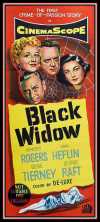 In
order to be certain that
my mother would maintain
her walk towards the Essoldo,
I often had to resort
to subterfuge! I
began this prior to our
leaving home. My mother
liked certain actors and
would always want to see
their films. George Raft
was one such actor and
James Cagney another.
I began my subterfuge by
telling her that a George
Raft film was showing
at the Essoldo. This
would be sure to peek her
interest. Next I would
reinforce her interest by
giving her a synopsis of
the film, which
was often not quite the
truth. My mother liked the
gritty films of Warner
Brothers that starred
her favourites and others
including Edward G.
Robinson, The Dead End
Kids and Humphrey Bogart.
She also liked films with
dancing. Both George Raft
and James Cagney were
good actors and both
danced – the perfect
combination as far as
she was concerned.
Knowing her tastes, I
would pepper my
synopsis with little
white lies where I
pretended that one or
other of her favourites
would be either the
leader of a good gang or
else was a policeman and would
dance! Whether my
mother believed me or
not, I never knew, but I
would maintain my patter
along Bethnal
Green Road until I
felt certain that there
was no going back. Once
inside the Essoldo, I
would complain how the
management had changed
the programme and I would
feign disappointment
while settling down into
my seat to enjoy the
latest offering from 20th
Century Fox. My
mother never complained
about this change in
programme, I am happy
to say, and enjoyed the
film too. 20th
Century Fox did
produce one film in CinemaScope
starring George Raft,
Black Widow. Here he
played the policeman
investigating the murder
of a young woman. This
was one of those films
often produced at the
time, which were not
especially interesting,
but were memorable only
for the huge number of
stars appearing in it,
with this one including
Gene Tierney and Ginger
Rogers. In
order to be certain that
my mother would maintain
her walk towards the Essoldo,
I often had to resort
to subterfuge! I
began this prior to our
leaving home. My mother
liked certain actors and
would always want to see
their films. George Raft
was one such actor and
James Cagney another.
I began my subterfuge by
telling her that a George
Raft film was showing
at the Essoldo. This
would be sure to peek her
interest. Next I would
reinforce her interest by
giving her a synopsis of
the film, which
was often not quite the
truth. My mother liked the
gritty films of Warner
Brothers that starred
her favourites and others
including Edward G.
Robinson, The Dead End
Kids and Humphrey Bogart.
She also liked films with
dancing. Both George Raft
and James Cagney were
good actors and both
danced – the perfect
combination as far as
she was concerned.
Knowing her tastes, I
would pepper my
synopsis with little
white lies where I
pretended that one or
other of her favourites
would be either the
leader of a good gang or
else was a policeman and would
dance! Whether my
mother believed me or
not, I never knew, but I
would maintain my patter
along Bethnal
Green Road until I
felt certain that there
was no going back. Once
inside the Essoldo, I
would complain how the
management had changed
the programme and I would
feign disappointment
while settling down into
my seat to enjoy the
latest offering from 20th
Century Fox. My
mother never complained
about this change in
programme, I am happy
to say, and enjoyed the
film too. 20th
Century Fox did
produce one film in CinemaScope
starring George Raft,
Black Widow. Here he
played the policeman
investigating the murder
of a young woman. This
was one of those films
often produced at the
time, which were not
especially interesting,
but were memorable only
for the huge number of
stars appearing in it,
with this one including
Gene Tierney and Ginger
Rogers.
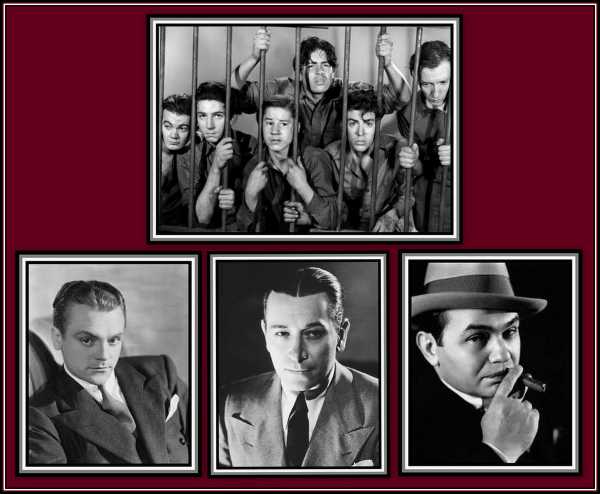
The Dead
End Kids,
James Cagney, George Raft
& Edward G. Robinson
Of all the
20th
Century Fox CinemaScope
Productions that I
saw at the Essoldo
Bethnal Green, there
were a number that were
memorable. These included
River of No Return,
Heaven Knows Mr. Allison,
White Feather and The
Deep Blue Sea.
River
of No Return was a film directed
by Otto Preminger of
Laura and later Carmen
Jones fame. The film,
filmed in the Canadian
Rockies, starred Robert
Mitchum and Marilyn
Monroe and centred on a
trip down a dangerous
river with murderous
rapids. Although the film
contained exactly what I
liked – marauding
Indians and Marilyn
– it was not without
fault and the major fault
lay with the clipped
delivery of her dialogue
by Marilyn herself.
Despite this, she looked
remarkable when dressed
either as a saloon
girl or in outdoor ware
and sang some really
great songs including the title
song,
which she did towards the
end of the film. For some
reason, the powers-that-be
had Tennessee
Ernie Ford sing the song over
the credits.

Heaven
Knows Mr. Allison
also starred Robert
Mitchum playing a lone
U.S. Marine on a deserted
island except for his
co-star, Deborah Kerr
playing a nun. Together
they hide and manage to
survive the Japanese
occupation once they
arrive. We follow their
tribulations until the
Marines arrive, when
they are separated to
continue with their
lives. The film, directed
by John Houston, received
both critical and public
acclaim, and was greatly
loved by my mother. I
remember that we stayed
in the cinema and watched
it a second time, which
was rare for my mother to
do. Although I enjoyed
the film too and have
always enjoyed the films
of Deborah Kerr, I found
her attempt at an Irish
accent to be both jarring
and painful.
White
Feather
is a western that has
never received the credit
that I have always felt
that it deserved. It
deals with the time of
Indian resettlement and
the refusal of two young
Cheyenne braves and the
challenge that they issue
to the U.S. Cavalry. The
film stars Robert Wagner,
Debra Paget and Jeffrey
Hunter, but to my
mind, it is Eduard Franz
playing the tribal
chief, Broken Hand, who
steals the film. Debra
Paget had already become
a firm favourite of mine
having fallen in love
with her, as the Louis
Jordan character
had, and wept copious
tears, as she walked
to her death to quench
the wrath of the volcano in
Bird
of Paradise.
Prior to this film, Robert
Wagner had left no
lasting memory.
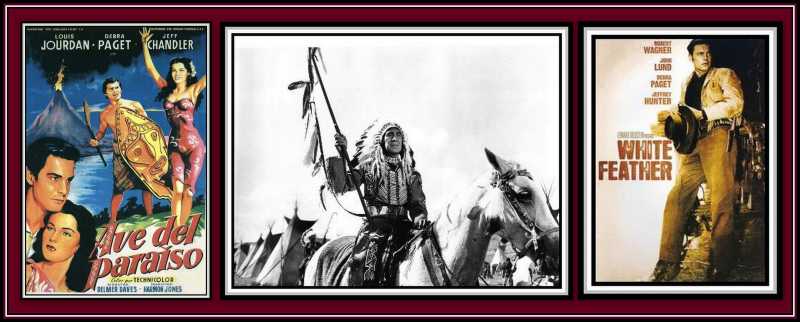 |
| Edward
Franz as Broken Hand |
Robert
Wagner was a young
actor at the time of the
advent of CinemaScope and
was under contract with 20th
Century Fox. He
appeared in their third
film produced in the
process, Beneath
the Twelve Mile Reef,
which I had seen at the Essoldo.
Unfortunately I was
not too impressed with
either him or the film.
He had little luck with
me either with Prince
Valiant
or Broken Lance.
However, here in White
Feather and
especially in A
Kiss Before Dying,
which he made with a
young Joanne Woodward, he
showed his potential.
What is interesting about
A Kiss Before Dying is
that although everyone
associated with it were
contracted by 20th
Century Fox, the film
was released through United
Artists and was shown
on the Odeon circuit
and not by the Essoldo.
The
film was remade
in 1991, and although it
had an impressive cast,
did not compare well with
the original.
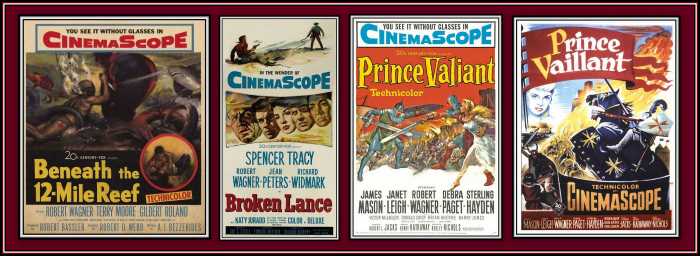
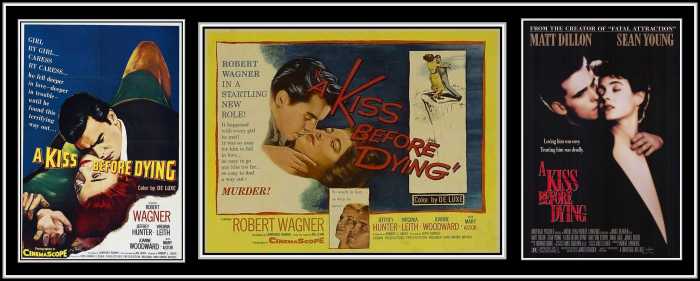
The
Deep Blue Sea was an
interesting film and was
based on the play of the
same name by Terrance
Rattigan and both
starring Vivian Leigh.
The film was directed by
Anatole Litvak and had a
particularly strong
supporting cast. Ms Leigh
played Hester Collyer,
the wife of a British
High Court Judge, played
by Emlyn Williams, who
leaves her husband after
a number of years of
marriage for an ex-R.A.F.
pilot, played by Kenneth
Moore, who calls her Hes.
They live, I believe, in
a bed-sit in the
once seedy area of
Pimlico in London. I
often go to Pimlico
during my visits to
London and always marvel
at how un-seedy
the area is now. Things
do not go well for the
couple: he takes various
jobs as a flyer, but
crashes while working in
Canada. We meet Ms Leigh
after she has attempted
suicide and is in the
process of being revived
by a neighbour who lives
in the bed-sit
below and played expertly
by Eric Portman. Mr.
Portman is another of
those actors with a
memorable voice. It seems
that the neighbour is not
without his past
and appears to be a
doctor struck off the
medical record.
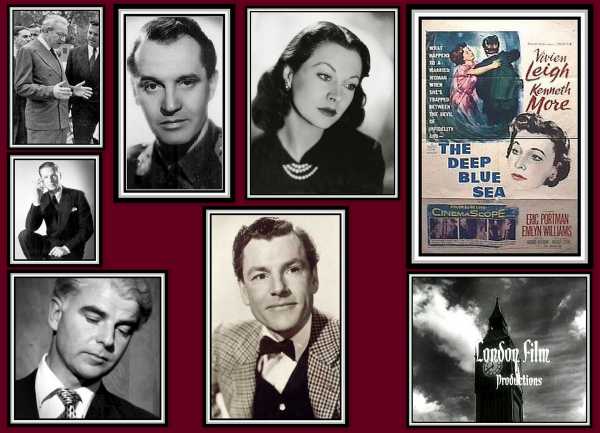
Alexander
Korda with Orson Wells,
Eric Portman, Vivian
Leigh,
Terrance Rattigan,
Emlyn Williams &
Kenneth More
Despite my
young age and the lack of
action in the
film, I was fascinated by
it and have remembered
it. However, the outing
to see this film was not
without a certain
sadness! I had persuaded
my mother to see this
film despite her wish, as
usual, to go to the Excelsior.
Unfortunately we arrived
late at the cinema and
did not, as was usual, see
the ending before we saw
the beginning. This
proved to be most tragic,
as we had to leave the
cinema before
the film ended. My father
was working late shift
that day, which meant
that he could be home
anytime after 10.30 p.m.
Sadly, the film did not
end until this time.
There was a very good
chance that he would be
late since he was always
late coming home at that
time as he was drinking
heavily with his friends
once his shift was over.
However, my mother did
not wish to take the
chance that he would be
home early and risk a
confrontation with him
were he to arrive drunk.
My father always took
which the offensive when
he had drunk too much and
an argument would
generally ensue. As a
result of our need to hot
foot it home, I
missed the ending of the
film.
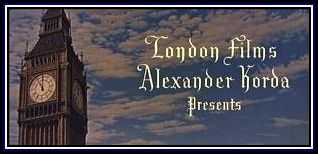 Adding
further to my tragedy
is that I have never seen
this film being
advertised to be shown on
television. It has since
never been released
either on videotape or
disc. Although this film
was photographed in CinemaScope,
it was not produced by 20th
Century Fox. It was
produced by Alexander
Korda’s London
Films, but was
released by Fox
and shown on the Essoldo-Granada
circuits. Since London
Films seems to no
longer exist, I fear that
all prints of this film
have been either
discarded or lost. Of
course, I live in
continual hope that a
print will suddenly be
found and that someone
will realize its value
and set about restoring
it for public viewing. I
shall, however, not hold
my breath. The play was
revived in 2009 on the
London stage and I hoped
that this would generate
some interest in the
film. Alas, the
production failed to
generate much interest
and it closed after a few
performances. Adding
further to my tragedy
is that I have never seen
this film being
advertised to be shown on
television. It has since
never been released
either on videotape or
disc. Although this film
was photographed in CinemaScope,
it was not produced by 20th
Century Fox. It was
produced by Alexander
Korda’s London
Films, but was
released by Fox
and shown on the Essoldo-Granada
circuits. Since London
Films seems to no
longer exist, I fear that
all prints of this film
have been either
discarded or lost. Of
course, I live in
continual hope that a
print will suddenly be
found and that someone
will realize its value
and set about restoring
it for public viewing. I
shall, however, not hold
my breath. The play was
revived in 2009 on the
London stage and I hoped
that this would generate
some interest in the
film. Alas, the
production failed to
generate much interest
and it closed after a few
performances.
(click on
the picture to hear Big
Ben)
The last
film that I saw in CinemaScope
at the Essoldo
Bethnal Green proved
to be a special film and
one which has been
re-seen and enjoyed a
number of times over the
years. My parents like so
many people of their
generation enjoyed
musicals. Most musicals
that I saw with them were
made by MGM and Warner
Brothers, however we
did see some made by 20th
Century Fox. As was
the way then, Fox musicals
had a distinctive look
and even I, as a
child, was able to
recognise which studio
made a particular
musical. I suspect that
it was the colour process
that stamped these films
like a trademark and
made them distinctive.
Many of the Fox musicals
that I remember seeing as
a child starred Betty
Grable with a couple
starring June Haver. In
the 1950s, Fox either
made and/or released a
number of musicals
written by Richard
Rodgers & Oscar
Hammerstein. Both Carousel
and The King and I
were both made and
released by Fox and
also became of interest
as being the only films
filmed in CinemaScope
55.
The company also
released South
Pacific, which was
filmed in TODD-AO.
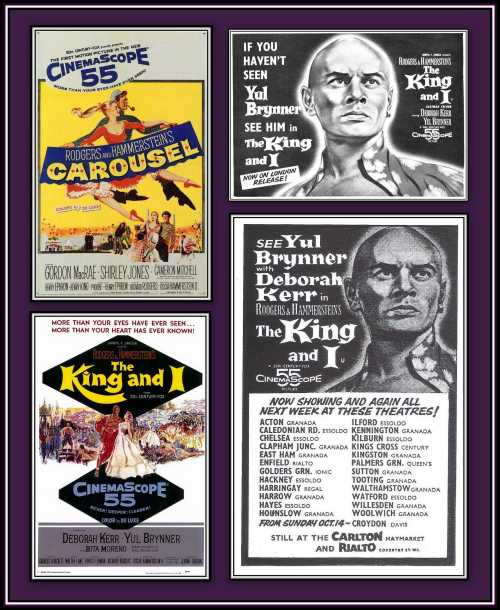
One of the
problems occurring with a
widescreen format was
that the increased
magnification of a 35 mm
film frame produced a
grainy image. Apparently VistaVision
had addressed this
problem through the use
of a larger print. Fox
hoped that by
photographing a film that
produced a negative 55.625
mm wide and then
reducing the final print
back to a 35 mm
would overcome this
problem. They achieved
their aim, to some
extent, with their CinemaScope
55 system. Despite
the company’s faith
in the clarity of the 55
mm negative, they
never released a film
print using 55 mm frame
size, and soon
abandoned the process in
favour of the TODD-AO process,
which was used to
photograph their later
epics (Cleopatra,
Those Magnificent Men in
Their Flying Machines and
The Agony and the
Ecstasy) and
big-budget musicals (South
Pacific and The
Sound of Music).
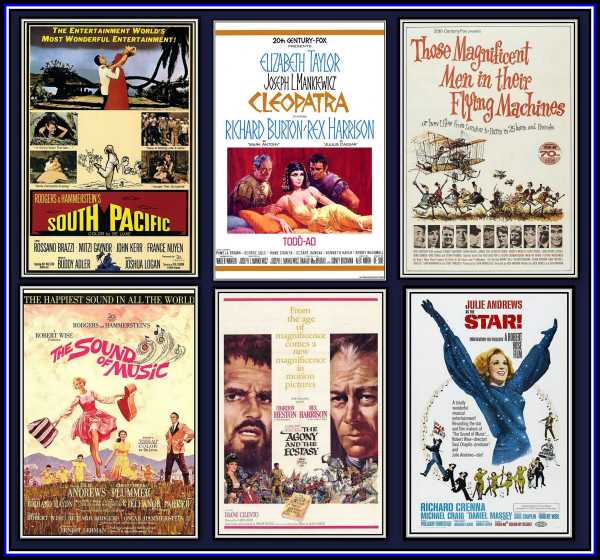
Tragically,
I have never seen Carousel
in a cinema. Yet
another example of my
deprived childhood! My
father was working early
shift during the week
that the film was shown
at the Essoldo Bethnal
Green and was
arriving home late from
work thanks to his
drinking with friends.
During that period, my
mother and I suffered
much from his behaviour
and things were coming
to a head. But this
is another story and will
be saved for another
time.
The last CinemaScope
film that we did see
at the Essoldo was
The
King and I.
The film tells the
story of Mrs Anna
Leonowens, an English
woman who goes to Siam to
teach the royal children,
and follows her dealings
with the King. This was a
musical adaptation of the
story previously filmed
by Fox, Anna
and the King of Siam,
starring Irene Dunne
and Rex Harrison. The
film was a delight to
see. Each tune was
memorable and helped move
the story along. There
were excellent
performances from both
Yul Brynner and Deborah
Kerr, but what I
found truly memorable
were the performances of
the beautiful and
talented Rita Moreno, who
later went on to greater
fame playing Anita in
West
Side Story
and the wonderful Terry
Saunders who
played Lady Thiang and
gave a terrific rendition
of the song Something
Wonderful.
The King and I was
such a great success when
first released in 1956
that Fox re-released
it several months later.
This was something hardly
ever done at that time.
Until then, the only film
that I recall being
re-released was The
Great Caruso
with Mario Lanza in
1951.
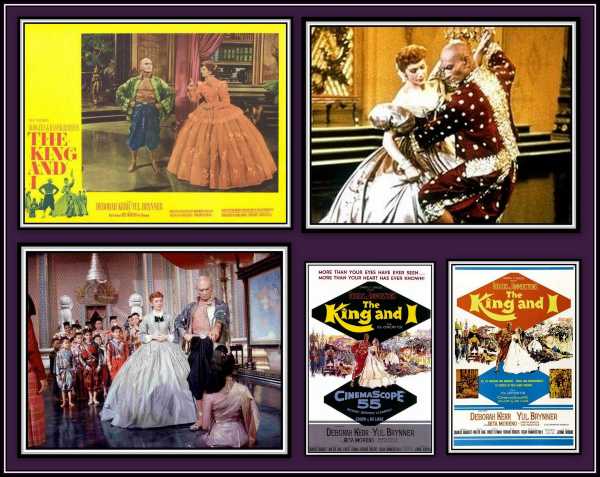
 The
last non-CinemaScope
film that I saw at the Essoldo
was The Flesh is Weak.
This film dealt with
prostitution in London
and showed how a man was
able to persuade a woman to
go on the game for him.
Although this was far
from being an important
or even memorable
film from a
cinematographic point of
view, it was nonetheless
memorable to me since it
was the first X-certificate
film that I saw. As I
said earlier, only those
members of society of
16-years and older were
supposed to be admitted
to see this film. Cinema
managements were subject
to hefty fines should youths
be found admitted to
showings of such rated
films. What made seeing
this film remarkable
for me was that I had
only reached the ripe
old age of twelve
years at the time!
Although I was the envy
of my friends at having seen
an X, to be honest,
I cannot accept credit
for fooling the
box-office staff into
believing that I was of
age since, and here is
something that still
amazes me, I was taken to
see this film by my
parents! I cannot say
that I duped my
parents into seeing this
film, as I had given my
mother the gist
of the story several days
before we went. I assumed
that when we went out
that evening, we would be
going to the Excelsior.
Anyway, my entry to the
auditorium was not
barred. I remember
entering the cinema foyer
with some apprehension,
but my parents were not
questioned about my age
either when they bought
the tickets or when they
were presented to the
usherette. I can only
conclude that I must have
been invisible
to everyone that evening! The
last non-CinemaScope
film that I saw at the Essoldo
was The Flesh is Weak.
This film dealt with
prostitution in London
and showed how a man was
able to persuade a woman to
go on the game for him.
Although this was far
from being an important
or even memorable
film from a
cinematographic point of
view, it was nonetheless
memorable to me since it
was the first X-certificate
film that I saw. As I
said earlier, only those
members of society of
16-years and older were
supposed to be admitted
to see this film. Cinema
managements were subject
to hefty fines should youths
be found admitted to
showings of such rated
films. What made seeing
this film remarkable
for me was that I had
only reached the ripe
old age of twelve
years at the time!
Although I was the envy
of my friends at having seen
an X, to be honest,
I cannot accept credit
for fooling the
box-office staff into
believing that I was of
age since, and here is
something that still
amazes me, I was taken to
see this film by my
parents! I cannot say
that I duped my
parents into seeing this
film, as I had given my
mother the gist
of the story several days
before we went. I assumed
that when we went out
that evening, we would be
going to the Excelsior.
Anyway, my entry to the
auditorium was not
barred. I remember
entering the cinema foyer
with some apprehension,
but my parents were not
questioned about my age
either when they bought
the tickets or when they
were presented to the
usherette. I can only
conclude that I must have
been invisible
to everyone that evening!
On the 6th
November, 1956, we moved
to Langley. Both my
mother and I were soon
missing London and we
missed Bethnal Green much
more than we could have
realised. Although
Langley could hardly be
considered to be in
the country, we were
very urban and
were not used to the
quietness that suddenly
surrounded us in our
home. I remember that we
missed the sound of
traffic more than
anything. Amidst our
sadness, we were
delighted when we learned
that The
King and I
was to be shown at the Granada
Slough. We could not
wait to see it again. I
remember that we enjoyed
it just as much this time
as we had several months
earlier at the old Essoldo
Bethnal Green.
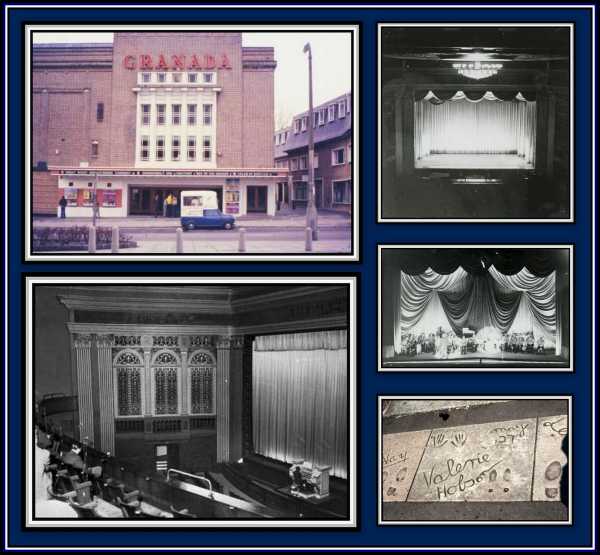
Granada
Slough and its Walkway
of Fame
Once I
moved out of London, I
only went into the Essoldo
on one other
occasion. By then the Essoldo
circuit no longer
screened 20th
Century Fox CinemaScope
Productions and had
been reduced to showing
films of lesser
importance. The last film
that I saw there was The
Duke Wore Jeans with
Tommy Steele. At this
time, the décor of the
cinema had become even
seedier in
appearance, which caused
me some sadness. The
seats were now in a
terrible state of
disrepair and the walls
were scarred and marked
from lack of attention.
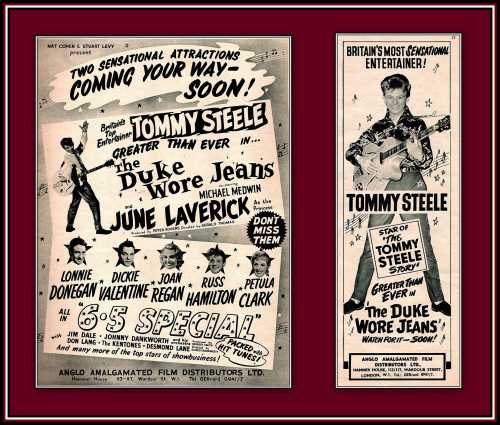
With the
further passage of time,
the presentations grew
poorer and the cinema
slipped into showing
second rate films that
had been shown elsewhere
without much success.
Sadly, the cinema closed
on 5th August,
1964 after showing Devil
Ship Pirates with Christopher
Lee and The
Invincible Seven with
Tony Russell.
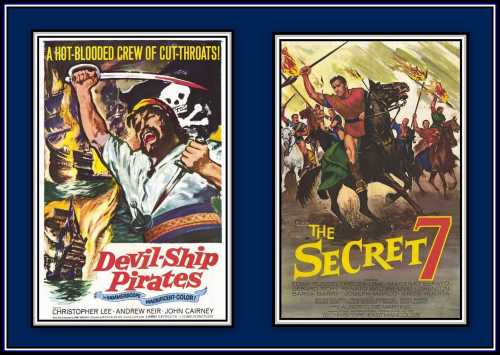
The
Secret Seven was
released in Britain as The
Invincible Seven
Soon
after, it closed as a
cinema, it became a Bingo
Hall and the building
functioned as such until
about 1990. The
founder of the Essoldo
chain had been dead
set against Bingo. Even
in the face of a falling
cinema audience, he
refused to consider the
conversion of his cinemas
into Bingo halls in order
to bring in
revenue. Unfortunately
for him, once he died and
his empire passed
into the hands of others,
many ex-Essoldos were
converted and used for
Bingo.
Although
the Essoldo, Bethnal
Green Road is no
longer a cinema, the
building is still present
and a number of features
of the old auditorium
survive. As I said, the
auditorium is now a
warehouse and used to
store fabrics and
cottons. Thanks to the heart
and consideration of
the present owners, the
building has been
maintained and renovated
and many people come from
all over the world to
photograph it and to
marvel at its design. The
present state of the
building is a credit to
the owners and to Bethnal
Green – thank
you Frankle Trimmings!
I
would like to thank Mr.
Brian Hall and Mr. Kevin
Wheelan for their
kindness in allowing many
of their pictures to be
reproduced here.
|